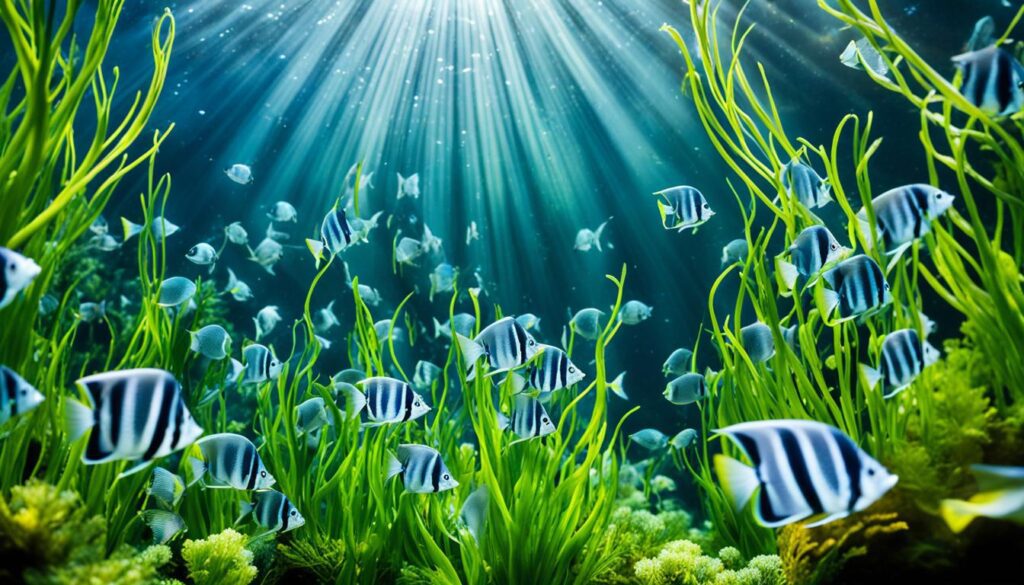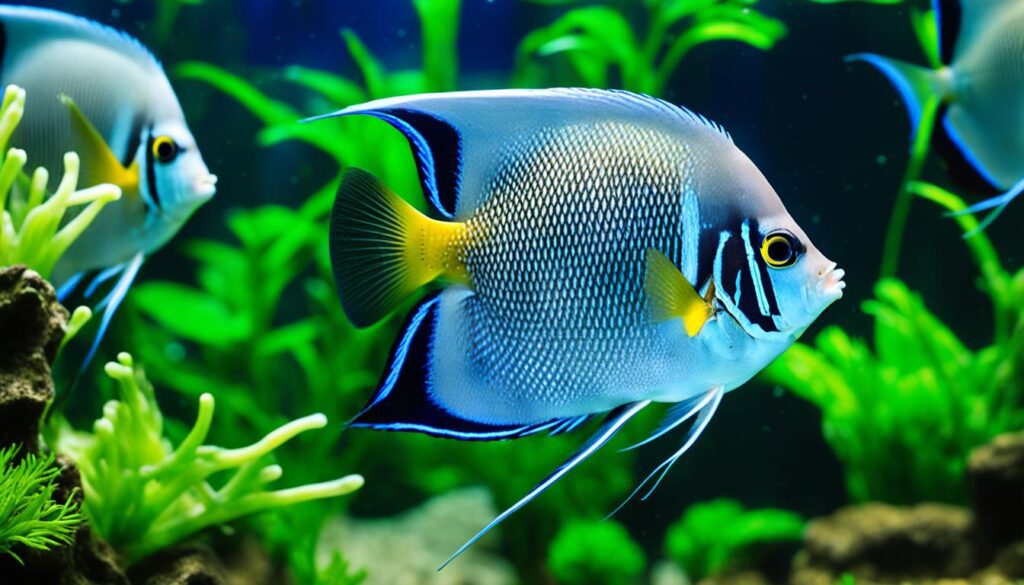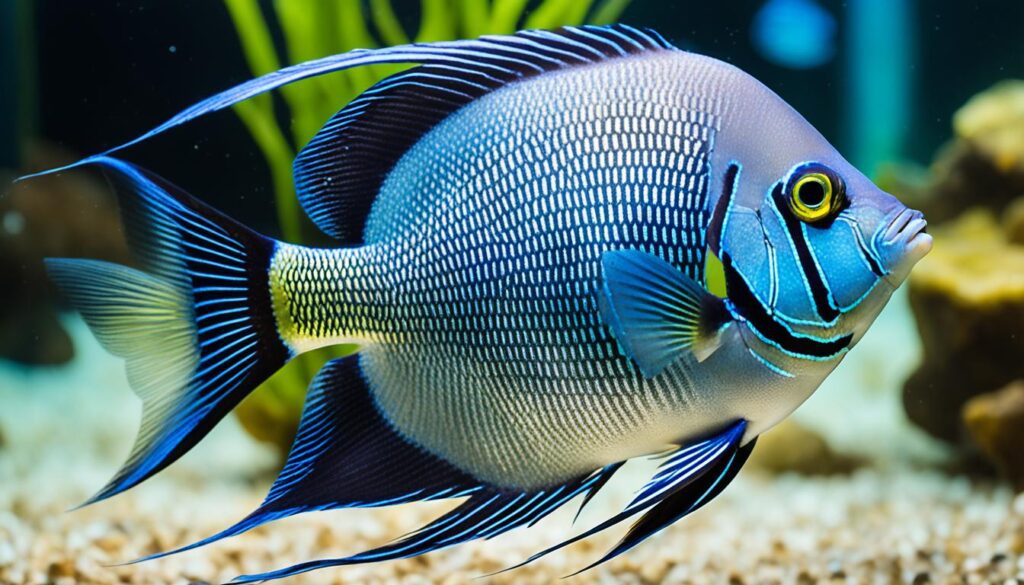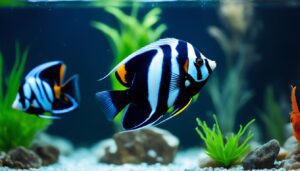Keeping a freshwater angelfish is like bringing a piece of living art into your home. Known as Pterophyllum scalare, these stunning fish hail from the lush rivers of South America. Their sleek silver bodies and the way they glide through the water give an elegant touch to any aquarium. Whether they’re swimming solo or moving in sync with others among the plants, it’s like watching art in motion.
For both beginners and seasoned fish enthusiasts, understanding how to care for freshwater angelfish is essential. With proper care, these beauties can live anywhere from 8 to 12 years, showing off their unique fin patterns, like the striking marble or veil varieties. More than just a pet, a silver angelfish is like a little piece of nature’s masterpiece, thriving when given the right food and attention.
If you’re interested in breeding, silver angelfish can bring both joy and potential rewards. A successful breeding pair can produce hundreds of fry, turning your hobby into a self-sustaining venture. While prices for angelfish can vary, the satisfaction of raising these graceful creatures far outweighs any financial gain.
Discovering the Silver Angelfish: An Aquarist’s Primer

When I explored the realm of Freshwater Cichlids, the Silver Angelfish caught my eye. These fish hail from the Amazon’s slow rivers and floodplains. Their Silver Angelfish Varieties have striking fins, like wings, adding beauty to any tank. A perfect Angelfish Habitat has calm, acidic water, sandy grounds, and lots of plants.
Learning about these fish showed me the importance of their habitat. Good water and a tank setup like their home are key for healthy, happy fish. Here’s what I learned on how to make a great home for angelfish and their friends:
Fish Species |
Tank Conditions |
Issues Noted |
Improvements |
|---|---|---|---|
Silver Angelfish and Platies |
26-gallon for 1 year, pH 7.5, GH 60, KH 120 |
Platy stress, the occasional angelfish bullying |
Adjusted water hardness, introduced floating flake food |
Angelfish Interaction |
Bright lighting |
Aggressive behavior in bright light |
Optimized tank lighting and added vegetation for hiding |
Angelfish Health |
No nitrates/nitrite, no ammonia, elevated pH |
Loss of appetite, possible oxygenation issues |
Improved water cycling, introduced air stones |
Feeding Strategies |
Frozen bloodworms, daphnia, flake food |
Ignored sinking food, preference for floating types |
Consistent feeding with preferred food, moderate portions to prevent overfeeding |
Caring for Silver Angelfish has been a journey of discovery. I’ve learned to fine-tune the aquarium, seeing their natural beauty shine. For those interested in Silver Angelfish Varieties, the right Angelfish Habitat promotes thriving life. It turns your tank into a captivating view, just like the Amazon’s lush landscapes.
Caring for Your Silver Angelfish: An Expert’s Recommendations

Welcome! Preparing a home for Silver Angelfish is more than just adding water. It’s about understanding and managing different elements for a healthy environment. Today, we’ll talk about the best ways to set up your Silver Angelfish tank. We aim for our fish to do more than just survive—they should flourish.
Creating the Ideal Habitat for Thriving Angelfish
Start with a tank of at least 20 gallons for your Silver Angelfish. This gives them room to grow and move freely. Adding plants like Java Fern and Anacharis not only looks good but also gives your fish a feel of the Amazon. Such plants provide hiding spots, which are important for these shy fish.
Maintaining a water temperature between 75-82°F (24-28°C) is key for their health. It supports their immune system and breeding. This temperature range is similar to their Amazon home, making it perfect for Silver Angelfish.
Water Parameters: Finding the Right Balance
To keep the best water quality for your Angelfish, get a top-notch filter. Checking and adjusting the pH levels between 6.5 and 7.5 is important. Though Angelfish can adapt, they do best in water that’s like their original habitat. So, it’s good to adjust the hardness of the tank water from time to time.
Here’s a quick look at the ideal water stats:
Parameter |
Ideal Range |
|---|---|
Water Temperature |
75-82°F (24-28°C) |
pH Levels |
6.5 – 7.5 |
Water Hardness |
Adjustable to mimic natural habitat, generally soft to moderately hard |
The Social Life of Silver Angelfish: Tank Companions and Solitude
For a Silver Angelfish community tank, pick tank mates carefully. Good choices are larger tetras, Corydoras, and some dwarf cichlids. Stay away from tiny or aggressive fish that might bother your Angelfish. Also, make sure there’s enough space for all to reduce stress and fighting.
If you see signs of stress or fighting, act quickly. Early action lets you adjust the environment or the group in the tank to keep peace.
Unveiling the Beauty of Silver Angelfish: Strains and Variants

I love to talk about Silver Angelfish Colors, Angelfish Varieties, and Freshwater Angelfish Patterns. They’re not just elegant and calm. Their colors and patterns make your aquarium look like live art.
The way these fish are bred is as interesting as they are. Aquarists often use inbreeding to get and keep the traits they like in Silver Angelfish. They do things like breed brothers and sisters or parents to children. This is to make sure genes that cause certain colors or patterns get stronger. If you want to know more about breeding fish in tanks, it’s important to understand the good and bad sides.
It’s exciting to see new Angelfish Varieties come up from careful choosing and breeding. This process not only makes certain genes stronger. It also brings in new mixes of genes. For example, mixing traditional silver with unusual patterns makes a lot of beautiful fish. Each one looks different, with its own special marks on its fins and body, showing off their Freshwater Angelfish Patterns.
Common Pattern |
Breeding Method |
Impact on Genes |
|---|---|---|
Koi |
Inbreeding (sibling-sibling) |
Enhanced red and white spots |
Marble |
Crossbreeding (different breeds) |
Random swirls of dark and light |
Leopard |
Inbreeding (cousin-cousin) |
Maintains spot density |
Each Silver Angelfish Color and pattern is a true sight to see. They really appeal to anyone wanting to add some sparkle to their tank. Whether you like shiny silver or lively spotted ones, Silver Angelfish add both peace and color to fresh water.
The Dietary Needs and Feeding Strategies for Silver Angelfish

It’s vital to feed Silver Angelfish the right diet for their health and long life. These fish, known for their striking fins and patterns, need special nutrients to stay vibrant and healthy. Here, we’ll explore how to feed them properly to keep them thriving.
Fueling Growth and Vitality with the Proper Nutrition
A mix of foods is crucial for Silver Angelfish. They do well with krill flakes, freeze-dried bloodworms, and quality pellets. This variety, including both floating and sinking foods, matches their natural eating habits. It gives them a choice and mimics their natural environment. For breeding Angelfish, adding high-protein foods like frozen bloodworms can help. It boosts their fertility and the health of their eggs.
Using live foods can make Angelfish feeding more natural. Feeder guppies, blackworms, and adult brine shrimp offer great nutrition. They also make the Angelfish hunt, which keeps them active and happy.
Special Considerations for Feeding Angelfish Fry
The first days are critical for feeding Angelfish fry. Live baby brine shrimp are essential for their early diet. These young fish need plenty of protein to grow strong. Foods like Hikari First Bites are great. They provide all the vitamins and minerals needed.
Fry survival rates can be low at first but usually improve. As breeders get used to their roles, more fry survive. To prevent issues like deformities, it’s important to watch the fry closely. They need to be fed little and often with easy-to-digest meals.
Following these feeding tips can keep both young and adult Silver Angelfish healthy. Investing in quality food helps create a thriving tank. It’s not just about cost, but about caring for your aquatic family.
Navigating the Challenges and Joys of Breeding Silver Angelfish

Starting your journey to breed silver angelfish is both tough and rewarding. As someone who loves this hobby, I learned a lot about angelfish spawning and sexing angelfish. I want to share tips and knowledge to help you breed angelfish successfully.
Sexing Angelfish and Identifying Breeding Pairs
Telling male from female silver angelfish can seem hard at first. I found that raising a group of them from young is best. They often pair up naturally. Once you see pairs forming, you can move them to their own tanks to breed.
Creating a Breeding Environment and Encouraging Spawning
For a great angelfish breeding tank setup, you need a 20-gallon tank with stable conditions. I keep the water at 82°F and the pH a bit acidic to neutral. Adding structures like PVC pipes or broad-leaf plants gives angelfish perfect spots to lay eggs. Feeding them live foods like bloodworms also improves angelfish spawning conditions.
Caring for Angelfish Eggs and Fry: A Step-by-Step Guide
Angelfish eggs hatch in two to three days. The angelfish egg incubation period is key, so I keep the water extremely clean. About a week after hatching, when the fry start swimming freely, they need more care. Then, I feed them live baby brine shrimp and, later, fine powdered food. A good tip is to remove the parents to keep the fry safe and increase their chances of survival.
If you’re getting into raising angelfish, watching them grow is truly rewarding. Below, there’s a table with useful info for anyone starting or experienced in breeding angelfish. It can help you succeed in this exciting journey.
Parameter |
Recommended Condition |
Purpose |
|---|---|---|
Tank Size |
20 gallons |
Provides plenty of room for breeding and lowers stress. |
Temperature |
82°F |
Ensures the best conditions for breeding and egg incubation. |
Water pH |
6.5 – 7.0 |
Keeps the environment comfortable for laying eggs and fry growth. |
Feeding |
Live food (e.g., baby brine shrimp) |
Gives necessary nutrients for better fry survival. |
By following these steps and creating a caring environment, breeding silver angelfish can be not just possible but deeply fulfilling. It adds a rich experience to aquarium keeping.
Understanding Silver Angelfish Behaviors and Temperament

Getting to know Understanding Angelfish means watching the unique Angelfish Behavior closely. This is important if you are starting with Silver Angelfish. They are known for moving smoothly and being friendly. They show off a wide range of behaviors and have an interesting Silver Angelfish Personality.
Silver Angelfish prefer peace and need a space like their natural home. They claim areas for themselves, especially when living with other fish of similar or smaller size. Let’s explore how these fascinating fish behave in their water world.
- They are awake and moving during daylight hours.
- Stressed Silver Angelfish may look less colorful, but they brighten up when happy. This shows their mood and health.
- Knowing what stresses them is key to keeping their home just right, ensuring they are lively and well.
The interplay between an Angelfish’s personality and its surroundings is key. It’s vital for anyone wanting to keep a balanced aquarium.
Behavior |
Description |
Impact on Tank Atmosphere |
|---|---|---|
Color Display |
Changes colors based on stress and contentment levels |
Indicator of fish health and stress levels |
Social Interaction |
Engages with other fish unless threatened or overcrowded |
Influences tank dynamics and fish compatibility |
Activity Levels |
Active during the day, less so at night |
Affects feeding times and light settings in the tank |
The Silver Angelfish Personality is more than just looks; it’s about their actions, reactions, and way of life. Paying close attention to their needs and habits allows them to flourish. By ensuring the right environment and keeping an eye on their behavior, your Silver Angelfish will not only live but also thrive in their water home.
Health and Wellness for Silver Angelfish: Prevention and Treatment
For those passionate about aquatics, keeping Silver Angelfish healthy is a key part of the hobby. These fish come from South America and can get quite big, growing up to 6 inches long and 8 inches tall. They need a big tank, at least 55 gallons, with lots of space and plants to feel at home and stay healthy. This helps prevent stress and Angelfish Diseases.
Caring for Silver Angelfish requires knowing their needs. I feed young fish 3 to 4 times a day, but adults get less to avoid overfeeding. It’s also critical to keep the water at the right temperature, between 75 and 84 degrees Fahrenheit. Plus, regular tank maintenance, like filter cleaning every week and changing 10-25% of the water each month, helps keep them healthy. By following these Angelfish Care Tips, they’re less likely to get sick.
Changes in fish behavior can warn us about health problems. I quickly address issues like more mucus, fins sticking together, or weight loss to avoid bigger health concerns. When problems do come up, I isolate the sick fish right away and check the water’s quality and temperature. Good care, including the right food, regular checks, and a well-kept tank, is crucial. It ensures my Silver Angelfish live a long and vigorous life in their freshwater home.








